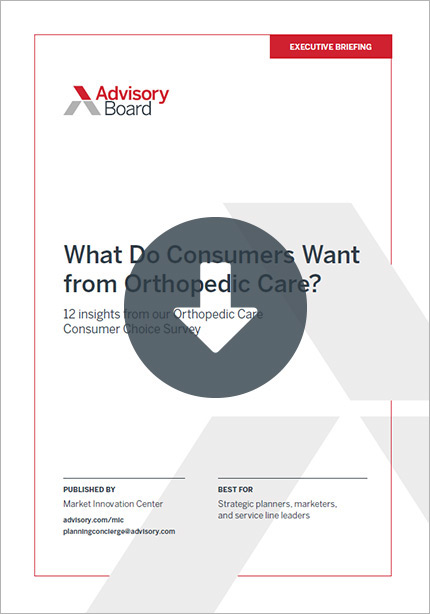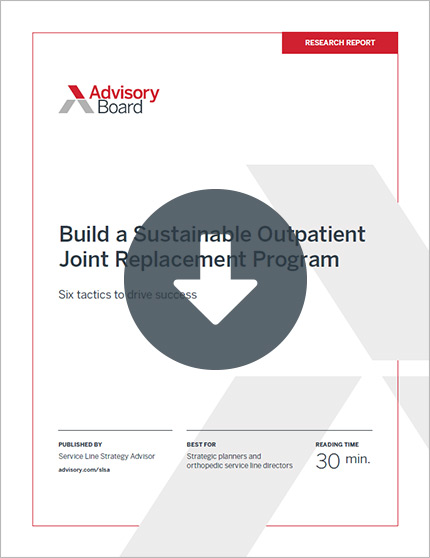Auto logout in seconds.
Continue LogoutEditor's note: This popular story from the Daily Briefing's archives was republished on Oct. 24, 2019.
To prepare for a projected rise in hip and knee replacements, Saint Francis Hospital and Medical Center (SFHMC) in 2007 launched its own bundled-payment program and soon after saw readmission rates and lengths of stay for the procedures fall below the national average, John Grady-Benson and his colleagues write in NEJM Catalyst.
Learn how to build a sustainable joint replacement program
Background
A team of surgeons in 2007 established the Connecticut Joint Replacement Institute (CJRI) at SFHMC "as a private physician-governed service line," Grady-Benson, a founding member of and quality officer at the institute, and his colleagues write.
The surgeons created the CJRI to streamline the joint replacement surgery process. At the time, health care systems were executing each part of a total joint replacement in isolation, which meant providers were "independently developing treatment plans rather than [taking] a team-based approach centered on the patient," the authors write. That resulted "in fragmented, duplicative, and costly care delivery," according to the authors.
The surgeons also recognized the isolated approach would not allow them to effectively handle a projected increase in joint replacement procedures as baby boomers aged. Experts estimated the annual number of joint replacement procedures would double between 2005 and 2015 from about 600,000 to 1.2 million, according to the authors. They explain, "The founding team anticipated that, as a result of multiple systemic inefficiencies related to physician communication, data collection, and payment models, existing hospital systems would be crippled by the predicted surge in patient volume."
"To address these chronic inefficiencies in the existing system," the authors write, "the founding team envisioned an outcomes-driven joint arthroplasty institute based on a 'hospital within a hospital' model, whereby a core of orthopedic surgeons from five previously competing private practices would provide administrative and consultative management for a joint replacement service line at [SFHMC]."
The team of surgeons launched the institute using the "unique 'hospital within a hospital' model," as well as a "data-driven decision-making process, accredited registry, and bundled payment program" to "facilitate excellent patient outcomes while continuing to reduce the per-case cost of joint replacement care," the authors write.
In particular, the institute "focused on [how] a specific practice and common set of procedures can better coordinate efforts among all health care providers," according to the authors. The initiative centered on a joint replacement registry with data on adverse events, emergency department visits, operative details, patient demographics, and readmissions, and "a single package price for a comprehensive set of health care services delivered by multiple providers over the full episode of care," the authors write.
Readmission rates, lengths of stay fall after institute launches
After the surgeons opened the institute, SFHMC saw the average length of stay for a knee replacement fall to 2.1 days, which is lower than the national average of 3.4 days, and the average length of stay for a hip replacement fall to 1.9 days, which is lower than the national average of 3.4 days. SFHMC also found that 87.4% of patients were directly discharged to their homes after a knee replacement, compared with the reported benchmark of 70.1%. In addition, 90.3% of patients were directly discharged to their homes after a hip replacement, compared with the reported benchmark of 70.4%.
SFHMC also saw hospital readmission rates for the procedures fall below the national average. Specifically, the hospital readmission rate was 3% for knee replacements, compared with 4.6% nationally, and 2.1% for hip replacements, compared with 4.6% nationally.
Further, the authors write that SFHMC "has achieved [infection] rates that are significantly lower than the national averages for primary knee and hip replacement surgery," at 0.3% for knee replacements, compared with 0.7% nationally, and 0.6% for hip replacements, compared with 1% nationally.
The program also boosted patient satisfaction, the authors write, noting that the Hospital Consumer Assessment of Healthcare Providers and Systems "scores for CJRI now consistently are approximately 98%, a substantial increase from initial scores of 82% for the same services prior to the creation of CJRI."
What they learned
Launching CJRI also allowed the group of surgeons to learn a few lessons, the authors note. For example, they write, "Clean, credible, actionable data represent the principal tool that leadership can harness to guide organizational adaptations associated with nationally evolving expectations of health care."
In addition, the authors write, "[I]t is critical to align all stakeholders around a common definition of high-value care (the most positive outcomes achieved at the lowest costs)" and to develop "a robust and consensus-based process … to ensure that every participant has an opportunity to provide thoughtful input" (Grady-Benson et al., NEJM Catalyst, 12/5/2018).
New: Learn how to build a sustainable joint replacement program
Increased payer coverage has moved outpatient joint replacements from differentiator to strategic imperative.
This report helps you navigate the transition to outpatient joint replacements with six tactics to build operational readiness to meet the new market reality, maximize reimbursement and cut costs to maintain margins, and partner with physicians to retain volumes within your health system.
Don't miss out on the latest Advisory Board insights
Create your free account to access 1 resource, including the latest research and webinars.
Want access without creating an account?
You have 1 free members-only resource remaining this month.
1 free members-only resources remaining
1 free members-only resources remaining
You've reached your limit of free insights
Become a member to access all of Advisory Board's resources, events, and experts
Never miss out on the latest innovative health care content tailored to you.
Benefits include:
You've reached your limit of free insights
Become a member to access all of Advisory Board's resources, events, and experts
Never miss out on the latest innovative health care content tailored to you.
Benefits include:
This content is available through your Curated Research partnership with Advisory Board. Click on ‘view this resource’ to read the full piece
Email ask@advisory.com to learn more
Click on ‘Become a Member’ to learn about the benefits of a Full-Access partnership with Advisory Board
Never miss out on the latest innovative health care content tailored to you.
Benefits Include:
This is for members only. Learn more.
Click on ‘Become a Member’ to learn about the benefits of a Full-Access partnership with Advisory Board
Never miss out on the latest innovative health care content tailored to you.


